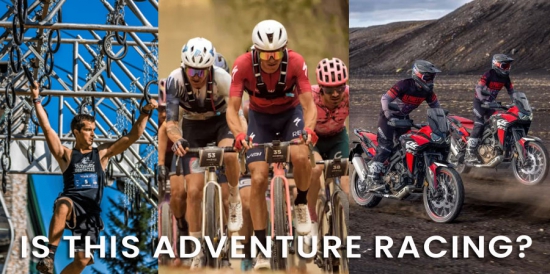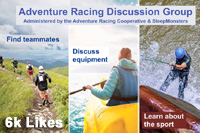Is it Finally Time for Adventure Racing to Stand up for Itself?
Rob Howard / 15.02.2023

What’s in a name? Everything!
A name is how we identify ourselves, our products and businesses, and it’s why brands are so fiercely protective of any misuse of their name. It’s why trademark law exists and the right domain names can sell for big money. Names matter. They matter a lot.
So how come, on a daily basis, obstacle course races, extreme trail runs, cycling events and even endurance motor-cycle trials are called ‘adventure races’? How did that happen?
If you don’t believe it follow these links. They are the tip of the iceberg.
Barbados Adventure Race (It’s an OCR)
Life Time Grand Prix Adventure Race Series (Endurance Cycling)
The Revenant Trail Run – ‘The 200km Adventure Race Hardly Anyone Finishes’
Dusi Canoe Marathon – ‘Africa’s Original Adventure Race’
Endure the Dirt Adventure Race (5K mud run)
Honda True Quest Adventure Race (Motorcycle challenge)
This has been going on a long time and while there is no sure way to pinpoint how it started, the root of the problem is in obstacle course racing. During the OCR boom a few years back many races suddenly began to refer to themselves as ‘adventure races’. Maybe they wanted to stand out from the crowd, or maybe they really did think they were just another kind of adventure race and had little idea what the real thing was.
The organisation now called World Obstacle was at the heart of this. Ian Adamson, one of the most decorated adventure racers of all time, has always been its president and always pushed the agenda the two sports are related or just different versions of the same thing.
Speaking in 2018 at the Primal Quest Expedition OCR World Championships in British Columbia he said the race was “really the long end of Obstacle Course Racing and the obstacles are very big; mountains, rivers, lakes, you name it.” He went on to say; “Many people these days are not familiar with adventure racing, it’s really a matter of wording, because adventure racing at the short end is OCR. It’s very similar with manufactured obstacles and people doing short courses, anything from one hour and up. Expedition OCR, or adventure racing is what we used to call it, is using natural terrain obstacles, and the obstacles are very, very big.”
The race was supported by World OCR, which later changed its name to World Obstacle, in partnership with Primal Quest and GODZone. It had a lot of media coverage, which spread the ‘adventure racing is OCR’ message, but few entries and little support from adventure racing teams.
Watching Ian Adamson’s comments on this race video, you can see why an OCR organiser might get confused, and where the rot set in.
https://www.facebook.com/EcoPrimalQuest/videos/523623081437193/
Unfortunately, it’s a message that continues today. Currently, on the World Obstacle website the page ‘Obstacle Sports in Popular Culture’ lists the TV shows ‘Raid Gauloises’ and ‘Eco-Challenge’ and on the page for the ‘sub-sport of adventure racing’ the ‘natural obstacles’ idea comes up again in the description; “Natural terrain obstacles such as mountains, deserts, rivers and oceans are common.”
The idea that oceans are just another obstacle like ‘the slippery wall’ or ‘the muddy ladder’ is obvious nonsense, but it’s out there and seemingly still being taken seriously, and it’s not good for adventure racing’s identity crisis.
It also fundamentally misunderstands how adventure racers relate to the environment and nature. Adventure racers don’t think of a magnificent mountain or a beautiful, fast flowing river as an ‘obstacle’, they are much more in tune with nature than that, and relish the time they spend in the great outdoors. The best teams are in harmony with their environment, not racing against it.
It wouldn’t be fair to lay the blame with all OCR events however, not everyone swallows the Adamson doctrine. This well reasoned article on the OCR World Championship website (nothing to do with World Obstacle) looks at the issue, and is worth reading. They are equally unhappy at OCR racers being called adventure racers! Their conclusion is; “Despite some brands trying to label races like Eco Challenge or Primal Quest as “expedition length OCR”, it is fundamentally a different sport.”
https://ocrworldchampionships.com/ninja-ocr-and-adventure-racing-three-different-sports/
As you can see from the examples above, the problem goes beyond OCR now. The genie was let out of the bottle and the words ‘adventure racing’ are now applied to a whole variety of sporting events. They are fair game for sloppy social media commentators, marketeers and copywriters, who don’t know, or care, whether adventure racing is something different.
They probably don’t know what real adventure racing is, which makes it easier for them to use the name for any kind of sport with an ‘adventure’ element. It’s an ironic twist that a sport that struggles to explain itself should have its identity challenged!
It’s going to be hard to put that genie back in its bottle and stop the misrepresentation of the sport.
Racers and race organisers have to do all they can to educate people about the sport, and that is now happening a lot more than it used to. Races are producing more videos and holding more online talks, training courses and starter events. There were a lot of ‘what is adventure racing’ posts and blogs around the time of the Eco-Challenge revival, which was a real boost to the sport.
Maybe it’s time to stand up for Adventure Racing and everyone passionate about the sport should challenge the events and organisations misusing our name to their own benefit.
Maybe it’s time to have a concerted campaign where all those involved in the sport shout loudly; “that isn’t a real adventure race ... this is an adventure race!”
It might be a way to turn the tide and publicise what adventure racing really is. The alternative is to do nothing, and then adventure racing’s identity will continue to be eroded.






 SleepMonsters
SleepMonsters



